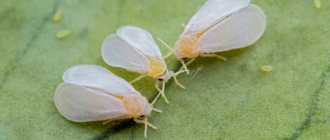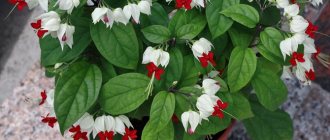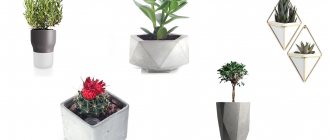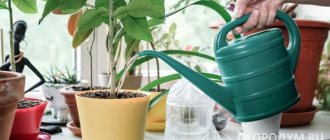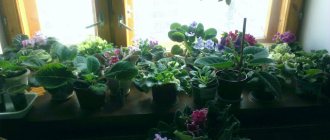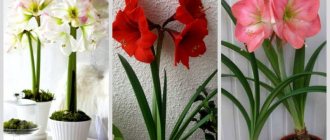Sometimes there is a situation where friends or relatives give a flower, but they cannot say what kind of plant it is.
Dear readers!
For you, we have created communities on social networks in which useful articles and interesting ideas are published several times a day! Subscribe and receive useful content in a convenient format! In this case, you have to look for information on your own to understand how to properly care for your new pet. After all, mistakes in care can be fatal for the plant.
In today's article we will look at ways to find out the name of an indoor flower from a photo.
What are the ways to find out the name of a flower?
There are several ways to find out the name of a flower:
- Search engines Google and Yandex. An old proven method is to search by image. You upload an image, and the robot searches for similar images. Among the disadvantages, random and completely unsuitable results are often added along with similar plants.
- Specialized resources. In essence, the sites are databases with information and images of various indoor and wild plants. The principle of operation may be different: uploading a photo and automatically searching or waiting for a response from the administration.
- Mobile applications. You take a photo of a flower, upload it to the application, and get the result. The quality depends directly on the application used and its database.
- Voice assistant Alice. The principle of operation is approximately the same as that of search engines, but with some innovations. Voice controlled.
- Encyclopedias, reference books. Proven option. But there is a huge disadvantage - in search of the right plant you will have to sift through a mountain of information.
- Flower shops. For many, the most accessible, but least accurate source of information. Flower shops rarely employ salespeople with botanist degrees. In addition, the main assortment is quite standard. Therefore, they may simply not know the name of the flower you ask them about.
NatureID
Like the other apps on this list, NatureID allows you to explore the world around you. With the option to upgrade directly to a premium plan after a three-day trial or continue with the limited free version, NatureID has a solution for everyone. It's ideal for both power users and casual enthusiasts.
When you identify a flower from a picture, NatureID pulls up an ID on it. On this map you will see:
- Factory name
- Its taxonomy
- List of subspecies
- Cultivation and practical use for the plant
- Additional information and sections (if necessary), such as symbolism and folklore
This last section is especially interesting. For example, with symbolism and folklore, the app talks about what flowers or plants had historical significance and what they symbolize now.
Unfortunately, NatureID is only available for iOS.
Download: NatureID for IOS (Free, subscription available)
Services that help you find out the names of plants
There are many sites on the Internet where you can find out the name of the plant you are interested in using a photo.
Let's look at the most popular and effective ones.
Plantarium
Plantarium, plantarium.ru is an online atlas of plants. From the list of services, select Plant Identification.
Next, you need to fill out a form, indicating parameters such as life form, appearance, habitat, ecology and features.
After that, click the “Find” button.
If Plantarium does not detect anything, then try changing some parameters. In addition, remember that the service is designed to determine the name of a flower or plant growing in Russia or neighboring countries.
That is, you won’t be able to find exotic species.
Tineye.com
This is not a specialized service for searching for images of flowers, but a resource for getting information about a specific picture.
Next to the search bar there is an arrow icon in a circle. Click on it and upload a photo from your computer.
Tineye will find similar images. Now you need to carefully study each link. Usually its description already contains the answer to the question, but there is a chance that you will have to visit the original site.
The principle of operation is similar to Google images.
Replies Mail
Mail.ru has long had an Answers service where you can ask your question.
You can access the service directly from the main website mail.ru.
The algorithm is like this:
- Click on the "Ask" button.
- A form appears that needs to be filled out.
- Write the topic, text of the question. Attach an image.
- Select the Animal Plants category and the desired subcategory. For example, "House plants".
- Click "Post Question".
- Wait for the answer. Often, along with the name of the flower, users will post a website describing how to care for the plant.
Yandex.Q
The principle of operation is approximately the same: some users ask a question, others answer.
The cue service can be found in the list of all company services on the website yandex.ru.
In the “Your question” field, write something like: “Tell me, what is the name of the flower?”, select the desired category, upload a photo and click “Ask”.
ON A NOTE. Activity on Yandex.Q has recently been significantly lower than on Answers Mail.
Groups on social networks
On social networks (VK, Odnoklassniki, Facebook) there are many thematic communities dedicated to growing indoor plants.
For example, on the social network VKontakte these are communities “What kind of flower?” (whatkindofflower) and “Flowers” (spireflowers).
about the name of the plant can be on the wall or in a special topic for discussion. Often, community members know many different colors and will tell you the correct answer.
IMPORTANT! We advise you to read the community rules first so as not to be blocked for violating them.
Happyflora houseplant guide
This resource happyflora.ru allows you to find the right flower in two ways:
1) using an online determinant. You must fill out a form that lists more than 20 characteristics of the plant.
2) by uploading a photo of the plant to the forum. Participants will help you determine the name. The principle of operation is similar to the community on social networks and the “Answers Mail” and “Yandex.Q” services.
Communities on social networks
The principle here is the same as on the forums. Join the community, upload a photo of your flower and ask members to tell you what it is called. As practice shows, you will have to wait some time to receive an answer.
Popular communities of gardeners and florists on VKontakte
- GARDEN FAIRY - Dacha. Garden;
- Blooming garden. Country house. Garden;
- Cottage Garden Vegetable garden.
Follow the link, write your question in the discussion thread and add a photo of the plant to the post.
Popular communities of gardeners and florists in Odnoklassniki
- World of indoor plants and flowers;
- Community of gardeners and gardeners.
In Odnoklassniki, to ask community members to identify a flower, you will need to create a new entry, for this:
- Join the group.
- Open the menu.
- Write a message asking to identify the plant.
To add a photo, click on the paperclip icon in the body of the message and select “Photo” from the menu that appears.
Popular phone applications that can help you find out the name of a flower from a photo
It is much more convenient to use a smartphone. You take a photo of your green pet, upload it to the app and get an answer to your question.
Below we examined the capabilities of the most popular programs for smartphones, with which you can find out the name of a houseplant or wild plant.
PlantNet
One of the most popular applications for searching for the names of various types of wild flora.
It's very easy to use:
- Install the program on your phone.
- Take a photo of the plant or select a ready-made image from the list of your pictures.
- Indicate what exactly you filmed.
- The application will offer several options.
ON A NOTE. The names will be in Latin, so you will have to use the Internet later.
PictureThis
In fact, it is a kind of social network for gardeners and flower growers from all over the world.
If the application does not identify the plant, you can make a corresponding mark on the photo.
Other users will try to help you.
Houseplant manager
This program does not have the largest database, but the most common flowers in our latitudes are collected here.
It helps not only to find out the name of the flower, but also tells you how to care for it.
Here you can make a cheat sheet on when to water and feed the plant.
LeafSnap
- You remove the plant.
- Indicate which part you removed.
- See the result.
PlantSnap
Has one of the largest databases.
It's free on Android, but requires payment on iPhone.
The application works in a classic way: take a photo of a plant, look at the proposed option. It may not always be correct, so it may take several tries.
ON A NOTE. Without a subscription, you can upload no more than a dozen photos in 1 day.
iNaturalist
A program that is similar to PlantNet.
The principle of operation is the same: take a photograph of an unknown flora representative and look at the proposed options.
Smartphone applications
Finding suitable applications was not the easiest task. Some are only paid by subscription, others ask you to install your camera in the root directory of the phone (I strongly do not recommend experimenting with such applications). And the third ones have such a low rating that you don’t even want to try. But a couple of applications were still found.
Plant ID
Plant ID is a paid and non-Russian application. And this is already a serious drawback to be excluded from the list. But one big plus outweighs the disadvantages: the application recognizes plants quite well. Plus, it has three free definitions per day, which is enough for occasional use.
To find out the name of your plant using Plant ID, follow these steps:
- Launch the application and close the payment message (a cross appears in the upper left corner 2-3 seconds after loading).
- Click on the image icon on the bottom panel.
- Click the green “Add new plant” button.
- Select the type of plant being identified.
- Take a photo of the flower so as to capture the plant as much as possible and not catch anything unnecessary.
- Wait until the application performs recognition (may take 2-3 minutes even on modern smartphones).
The most suitable option will always be shown at the top. As far as I know, my flower is Aloe Vera.
How to find out the name of a plant using Google Images
The Google search engine makes it possible not only to search for text queries, but also to search by images.
This is done as follows:
- On the search engine website google.com in the upper right corner you need to click on “Pictures”.
- A camera icon appeared in the search bar. Click on it.
- The “Search by Image” window appears. Go to the "Upload File" tab.
- Click the button and select the plant image file from your computer.
- Pictures appear that the search engine considers similar to your image.
- Find a plant similar to yours and go to the site where the image is posted.
- Find the title.
ON A NOTE. Yandex also has a similar service: Yandex.pictures.
PlantSnap
The PlantSnap photo identifier is more advanced than the previous ones. It has 2 sources of replenishing the information base: artificial intelligence and the users themselves. PlantSnap has been translated into 36 different languages, making it used in more than 180 countries.
Application Tools
The program interface is very simple. At the bottom there is a panel with icons where you can select one of these actions:
- take a photo in real time;
- upload a photo from the gallery;
- find a plant by name;
- make a publication;
- look at other people's publications.
After loading the image, the application determines what kind of plant it is and shows its name, as well as a short description. PlantSnap lets you share your discoveries and photograph your houseplants while adding gardening tips. The program allows you to subscribe to users who post interesting content and follow their news feed.
How does it work
The application works using machine learning technologies. Artificial intelligence learns to better recognize plants from photos thanks to repeated requests from people. In addition, users themselves can add to the database by publishing images with captions.
The developers claim that the program is familiar with 700,000 plant species from all over the world. She searches for objects not only from the photograph as a whole, but also from individual parts, for example, leaves, bark or fruits. PlantSnap recognizes different types of mushrooms, cacti, and weeds well.
Determination accuracy
PlantSnap does its job well. The accuracy of identifying plants is 97%, but users note that sometimes the program does not recognize a flower the first time. The photo is uploaded again, and then the application works.
How to determine the name using the Alice voice assistant
You can find out the name of a flower using Alice from Yandex.
First of all, download the Yandex with Alice application to your smartphone or install Yandex Browser on your computer.
Start a dialogue with Alice. Just ask “Alice, find the flower from the photo.”
Then upload the photo and wait for the assistant to display search results. Among the many pictures, find a plant similar to yours and open the site.
If necessary, repeat the procedure.
Common mistakes
In general, using the resources listed above to find out the name of a plant is not that difficult. However, there are still common mistakes that cannot be ignored.
- Poor quality photo. This includes a photo in the dark, a bad angle, and a blurry image. Remember, the better you photograph the plant, the better your chances of finding out its name.
- Violation of the terms of use. Each resource has its own rules. We advise you to read them before using them to avoid getting banned.
- Using only one application/resource. This is not a mistake, but rather a flaw. To get more accurate information, check the photo on at least two resources.
- Hope for 100% result. Unfortunately, no website or application can provide a 100% guarantee of accurate results. Therefore, there is always the possibility of error.
Answers to frequently asked questions
What service allows you to find out the 100% correct name of a flower?
Unfortunately, there is still a possibility of error. It is difficult to recognize some plants at the sprouting stage. Many related flowers are similar to each other. And, for example, not even every florist can distinguish between Amaryllis and Hippeastrum at first glance!
But the programs at least set the direction of the search.
How to photograph a flower?
Take the photo in such a way that the distinctive features of the plant are visible: the shape and size of the leaves, the color of the buds. Try to take a high-quality photo in good lighting.
What else should you pay attention to?
Avoid photographing a young plant or flower after pruning. This will greatly reduce your chances of finding out the correct answer.
And, of course, there should only be one flower in the image.
Can I contact the flower shop with a question?
Of course you can. And with a high degree of probability they will help you there, but the problem is that the sellers do not know the names of some exotic plants.
Classification of modern Saintpaulias
According to socket size
Conventionally, all Saintpaulias are divided into five groups according to the diameter of the rosette:
- large - from 40 to 60 cm (marked L);
- standard - from 20 to 40 cm (marking S);
- midi or semi-miniature - from 15 to 20 cm (SM marking);
- mini - from 6 to 15 cm (marked M);
- micromini - up to 6 cm (marked mM).
Classification of violets by rosette size.
The size of the rosette will correspond to the group when the conditions of maintenance are met - a mini can grow to the size of a standard in a too large pot, and a standard with insufficient nutrition will be tiny, like a mini.
Attention! The rosette also becomes larger with age.
By flower size
The size of the buds is very dependent on lighting, fertilizing and temperature.
Violets grown in the right conditions are divided into the following groups according to flower diameter:
- small-flowered - less than 2 cm;
- medium-flowered - from 2 to 4 cm;
- large-flowered - from 4 to 6 cm;
- especially large-flowered - more than 6 cm.
According to the shape of the flower
To understand how to determine the variety of violet by flower, you need to classify their forms.
Pansies
A flower with five petals, the lower three being larger. Reminds me of violets from my grandmother's dacha , familiar from childhood.
Star
All petals are the same size and shape, evenly spaced in a circle around the center of the flower. Classic round shape.
Bell
The buds do not open completely because the bases of the petals grow together . This flower looks like a miniature tulip or bell.
Violet Vallarta campanas Moradas (g. Beck).
Wasp
Five elongated petals form a bizarre shape - the upper two petals are twisted into a spiral, and the lower ones are pulled down.
The upper leaves are often very small, and the lower leaves, on the contrary, are larger and more massive. Reminds me of a bee on a leaf.
Bowl
The edges of the petals bend upward, forming a cup. The concave shape remains until the end of flowering.
According to the waviness of the edges of the petals
In this group, violets are classified as follows:
- corrugated or fringed - the edges of the petals are densely covered with elegant ruffles, often in a darker or contrasting color to the background: Angelica;
- EK Blue frost;
- NK March of Mendelssohn.
- EK Goddess of beauty;
- AB Red Carnation and others.
- Edge of Darkness;
- White Queen;
The meaning of the shape and size of the eye
In the center of the flower there may be a spot that is lighter or contrasts with the background , which is called an eye.
Violets are:
- without a peephole;
- with a dark eye;
- with a light or contrasting eye.
The outline of the eye can be sharp or gradually “dissolve” in the main color of the petal.
Fullness of petals
- single or simple flowers - an ordinary flower with five petals arranged in a circle in one row;
- comb flowers - to the five main ones, 2-3 small petals are added in the center of the bud;
- semi-double flowers - two rows of fully developed petals;
- double flowers - voluminous, fluffy flowers with three rows of petals or more.
Leaf structure and color
Based on the structure of the leaves, we identify several species. Let's consider which varieties have characteristic features for each type of leaf.
boy
An ordinary sheet of uniform green color over the entire surface:
- Beethoven;
- LE-Dark Tower;
- Humako Flame.
girl
In the middle of the leaf there is a light, white or light green spot.
Mas melody girl.
spoon
The edges of the leaf are curled upward, and there are clear convex bumps on the surface.
Buckley's spoon.
lance
Long, pointed leaves.
Chantaspring.
The leaves are densely pubescent and slightly pubescent . The color can be uniform green or variegated . Specks, polka dots, and a network of veins form spectacular patterns.
Such Saintpaulias look attractive all year round, regardless of flowering.
By type of variegation
We can highlight:
- bordering or Tommy Low - a bright white, pink, yellowish or beige border around the edges of the leaf. The border can extend to the middle of the sheet, be clear or blurry - but the center is always green;
- crown - the upper leaves of the rosette are much lighter, greenish-yellow or pale green. With growth, the color of the leaf blade becomes more and more saturated, and the lower leaves are completely dark;
- mosaic - pale green, brown, bronze pattern of spots and veins on the entire surface of the sheet. Often on one sheet there is a whole scattering of multi-colored dots and specks;
- spontaneous - the pattern appears only on some leaves, the rest are of a uniform color. Unpredictable coloring makes observing the plant even more interesting. It is not transmitted by propagation by cuttings or leaf fragments.
The underside of the leaf may have a lighter or pinkish tint, or may be coppery-reddish.
